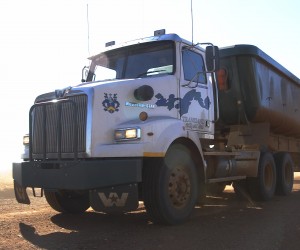Western Star was started in 1967 in Cleveland, Ohio, but by 1980, the original owner was insolvent, despite importing Semon E. "Bunkie" Knudsen, son of General Motors legend Semon Knudsen, and President of Ford Motor Company in 1969 - 1970.
In 1990, Western Star Trucks was purchased by Australian businessman Terry Peabody, who turned around the company's fortunes over the next 10 years, introducing the famed truck on South African shores after the fall of apartheid in 1994.
In 2000 the company was purchased by the Daimler AG North American truck division, and has carried on going from strength to strength. In most people’s opinion they are the premier tow truck company in the country, after considerable investment from the holding company.
Gregory Simpson caught up with Western Star Brand manager, Duncan Prince recently for more on the bulletproof build quality and heritage of these all-round value trucks.
Can you tell us a bit about Western Star in SA and your background?
Western Star has been in SA since about 1994. I’ve been involved with Western Star Trucks since 1997 and Western Star was bought by Daimler end of 2000, and launched as a Mercedes Benz South Africa brand in 2001. We’re a long way down the track with Western Star; we’re 15 –years-old under Daimler, and growing our market penetration significantly. Also the great service network and product support offered through our Daimler network has considerably enhanced customer’s faith in the product and we feel that we’ve been very successful in the niche markets where we have this product.
And this is arguably the best tow-truck in SA. What’s been the key to that success?
The big thing about Western Star being a good tow truck is in many respects the same as why it’s good in other applications. It’s because it’s built for a precise purpose. Towing other broken down trucks is not an easy job, so it is not a job that is well done by a normal off-the-shelf truck. The reason that our Western Stars have done so well is that we’ve built the trucks to cope with that arduous application, exactly for that purpose. Also we’ve brought the trucks into a country with towing equipment mounted on them, made in the US and Canada, so what happens is, customers that have bought the product have got a complete package from us that is basically the best that money can buy. When the product gets to SA there’s not a great deal of experimentation – you know of ‘maak a plan’ – or adaptation required. We know that it’s going to work from the get-go and we’ve got trucks running in SA as tow-trucks that are now 17 and 18 years old and still earning living for their owners, so we think that’s something to be quite proud of.
And what’s the maximum kilometre's you’ve seen on one truck?
The maximum kilometre’s that we’ve seen on one of our Western Stars is probably just under two million, but that in itself is not as significant as some of the hours that we’ve seen on our trucks. We’ve had some of our road-train trucks clock the other side of 40 000 hours.
Now just to put that in perspective: in a year there are give or take about 8 000 hours in a calendar year, 24 x 365, it is generally accepted that if you run a vehicle 24 hours a day, seven days a week with all of the stoppages for refuelling, driver changes, maintenance etc. If you can put 6 000 hours on a truck a year that is pretty good going, and what we’ve done is we’ve had trucks that are as old as eight years old and working it out, those truck engines have run for between 18 and 19 hours a day every day for eight years, which we think says quite something about the durability of our trucks. When you’re running the trucks in mining applications you can’t go as fast so you don’t clock mileage as quickly but it’s not to say that the truck is working any less hard.
What have we got under the hood of the Western Star in terms of horsepower?
This truck is equipped with a 15 litre Cummins ISX engine, it produces a maximum horsepower of about 530, or if you’re talking metric that’s 395 kilowatt, and it does 2 500 Newton metres – the bottom line is it just pulls like hell.
And in terms of Euro spec what’s this running at?
The truck runs at Euro 3, we would have probably moved on to Euro 5, you know, if Euro 5 fuels were freely available everywhere. There are also of course still some advantages to Euro 3 in that they are very, very well proven products and very, very reliable too.
If you had to get the crystal ball out, when might we see Euro 5/6 engines in SA?
We are probably going to be getting to Euro 5 around 2020, but it is a way away and I’m not even sure that the government will be ready by that stage, but the thing is the rest of the world would have changed to Euro 5 and we will find ourselves in a situation where just no one is prepared to build product that is anything less than Euro 5. We are a follower market, we take about half a percent of the global production of anything, whether it be trucks, wheelbarrows, tumble driers, microwave ovens, whatever, so in the rest of the world Euro 3 will not be manufactured in the next five years which will mean that, like it or not, we’re going to go Euro 5 and hopefully reap the benefits of cleaner air and better fuel consumption.
And in terms of manufacturing, where is Western Star built for SA shores?
This particular truck is built in Portland in Oregon, that’s in the North-West corner of America, in some respects it’s very far away, but other side of the coin is that a great number of our trucks that we build are built for export and they’re also built to run in applications which are very far from home, very far from help, so the vehicles are especially well built so that they can survive being far from their parents, if I can put it to you that way.
It is not unusual for trucks that come to SA to have to be tricked up a bit, but this one you can drive as is, or do a massive amount of modification.
Yes, well one of our big benefits on Western Star is that we believe we are one of the manufacturers who offer the highest degree of customisation and the most number of options ex-works out of any manufacturer in the world, and what we always say about Western Star is that we offer at least 3 200 options and failure is not one of them.
Why do most American trucks have bonnets, what are the pros and cons as opposed to cab-over?
The main reason why North American trucks are bonneted started out with a union thing. Truck drivers in a union in the States refused to drive cab-over trucks because they said that put you first at the scene of an accident, whereas with a bonneted truck you are separated by six or eight feet of bonnet. Over time what has happened though is bonneted trucks are better aerodynamically than cab-over trucks, because you’re pushing a wedge through the air rather than a square brick. The other thing is that bonneted trucks tend to cool better. What I mean by that is if you have very hot weather, you’re travelling slowly, pulling big loads, you can get much more airflow through a bonnet than you can underneath a cab, and your radiator is only as good as the amount of air that you can put through it, so if a bonnet lets you put more air through that radiator that engine stays cooler and tougher.
Why aren’t all trucks like this then?
Basically because SA tends to, in many respects, follow Euro regulation where overall length is dictated from bumper to end of trailer. Whereas in the US and Canada and also in Australia to some extent they legislate trailer-length only and they don’t necessarily legislate tractor length up front.
Gregory Simpson
[PULL QUOTE:] “If you’re talking metric that’s 395 kilowatt, and it does 2 500 Newton metres –the bottom line is, it just pulls like hell”
[PULL QUOTE] “There are also, of course, still some advantages to Euro 3 in that they are very, very well proven products and very, very reliable too”
[PULL QUOTE] “What we always say about Western Star is that we offer at least 3 200 options and failure is not one of them”













